It has long been evident that progress in TPM for the administrative division has been frustratingly slow. Perhaps this is not surprising, as TPM had its inception as an approach focused on plant maintenance. Another reason is that administrative work typically is not viewed as generating direct value-added, so administrative TPM has always consisted strictly of cost-reduction measures.
It is time for a reassessment. Inadequate information and services to the production sites where value is added provide an opportunity to boost exponentially the improvements (loss reductions) a facility can achieve. Without meaningful efforts to enhance the functions of the administrative division, any attempt to improve the constitution of management is doomed from the outset.
This article explains how TPM can be used to bolster the efficiency of the administrative division and use that newfound efficiency to energize the core functions of administrative staff. The discussion herein will begin with a MAKIGAMI analysis of the issues involved, then move to more specific suggestions for increasing efficiency in the administrative workplace.
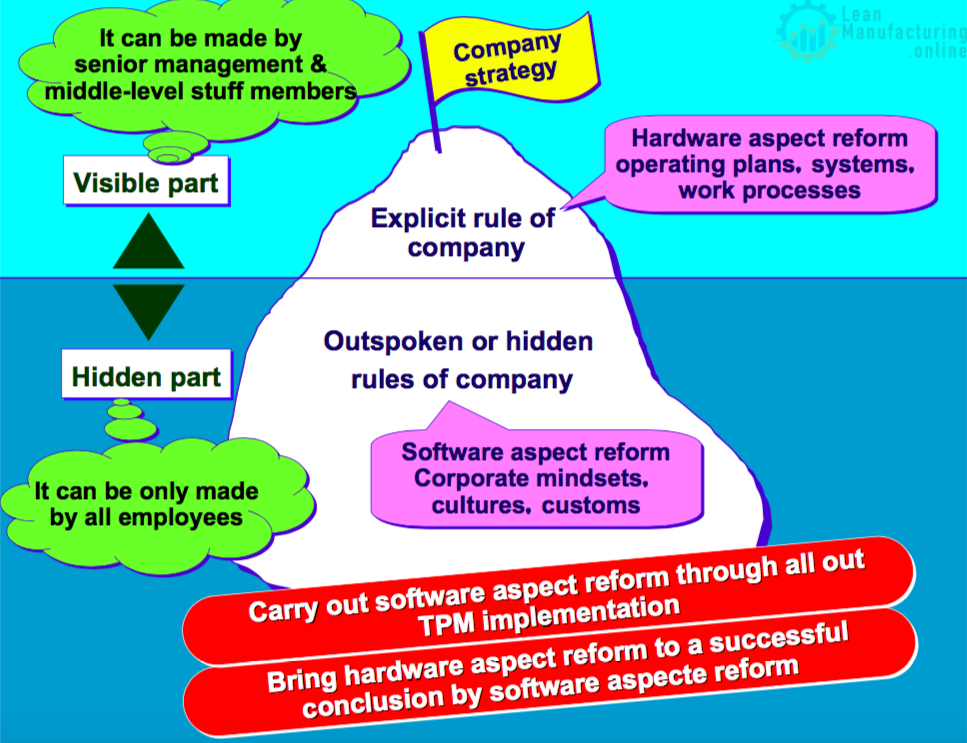
Constitutional Improvement and TPM
The improvement of an enterprise’s constitution includes both hardware and software aspects. If we think of an enterprise as an iceberg, the part that is visible above the waterline is the set of corporate rules made public as part of its strategies, such as operating plans, systems, and work processes. Improvement of the enterprise constitution is usually taken to mean reform of these “hardware” aspects.
In fact, however, the part is hidden below the waterline, the enterprise’s unspoken or hidden rules, form a much bigger component. This enterprise “software” includes corporate mindsets, cultures, and customs that cannot easily be changed simply by improving the hardware described above. For this reason, even the best-laid operating plans and systems are often shallow in effect and ultimately fail to make any lasting impact.
Whereas the company’s hardware is created by its senior management and some of its middle-level staff members, the software cannot be improved without every employee participating in and taking notice of the process. This is where the value of TPM lies.
To effect real and lasting change in the enterprise constitution, a company’s cultural software must be changed through TPM involving the participation of all members. This software change will in turn lead to success in reforming the hardware. This realization is critical for the improvement of the enterprise constitution to succeed.
What is to build a “character” for an enterprise?
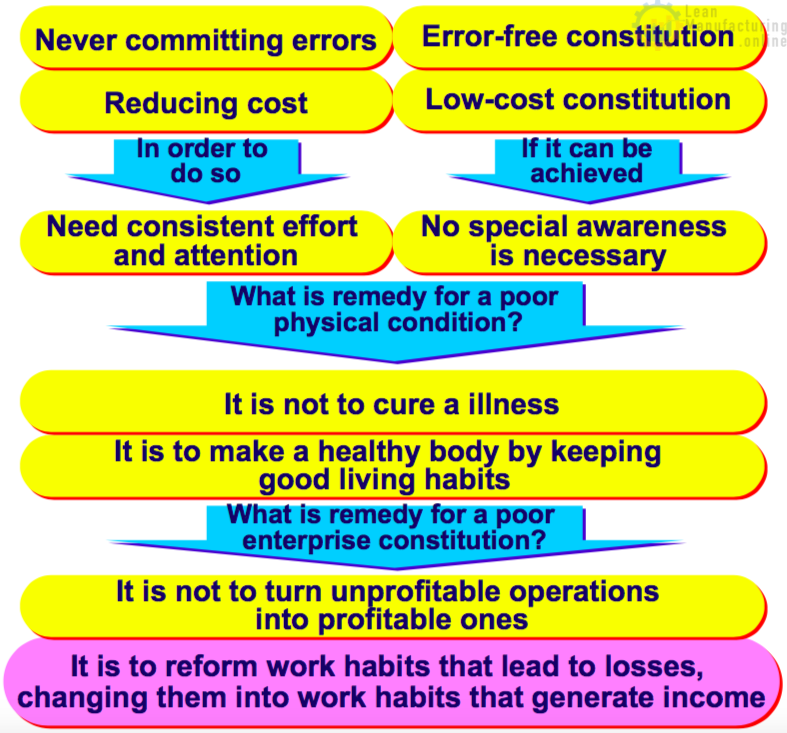
We will now turn to discuss in greater detail what it means to build a “constitution” for an enterprise.
The term “constitution” is used in the sense of a physical (as opposed to a political) constitution. For example, to succeed in themes such as “never committing errors” or “reducing cost,” each member of the organization must maintain consistent effort and attention to get the job done. Once the workplace has acquired an “error-free constitution” or “low-cost constitution,” these goals are achieved routinely through normal work and no special awareness is necessary.
When we remedy a poor physical constitution, we create a constitution that does not merely cure its illnesses, but a constitution that keeps good living habits so that the body does not easily fall ill. In the case of an enterprise, the point of improving the constitution is not to turn unprofitable operations into profitable ones but to reform work habits that lead to losses, changing them into work habits that generate income.
The enterprise thus gains a “profitable constitution,” generating income as an integral part of its routine operations.
Aim of Administrative Division

The effects of TPM can be described in general as follows.
- When activities are carried out, losses (such as the 16 major losses) decrease.
- As losses decrease, productivity rises.
- As productivity rises, the company’s business results (earnings) increase.
- As earnings increase, the company achieves “3S” (customer satisfaction (CS), employee satisfaction (ES), and social satisfaction (SS).
This, at any rate, is how the process is supposed to work. In reality, of course, this virtuous upward spiral is more complex:
- For activities to result in a reduction of losses, training and services are required.
- For loss reduction to lead to increased productivity, specialized technical support is needed.
- For increased productivity to boost earnings, the enterprise needs to acquire the appropriate technical information.
- To achieve 3S through the company’s business results, the company must project a sense of security and confidence.
Many more such examples could be listed here.
To put it another way, these activities tend to lead to the results indicated above, but though they are necessary they are not sufficient. Ensuring that the actions prescribed lead to the favorable results intended is the job of the administrative division.
Inadequate information and services from the administrative division to the manufacturing division
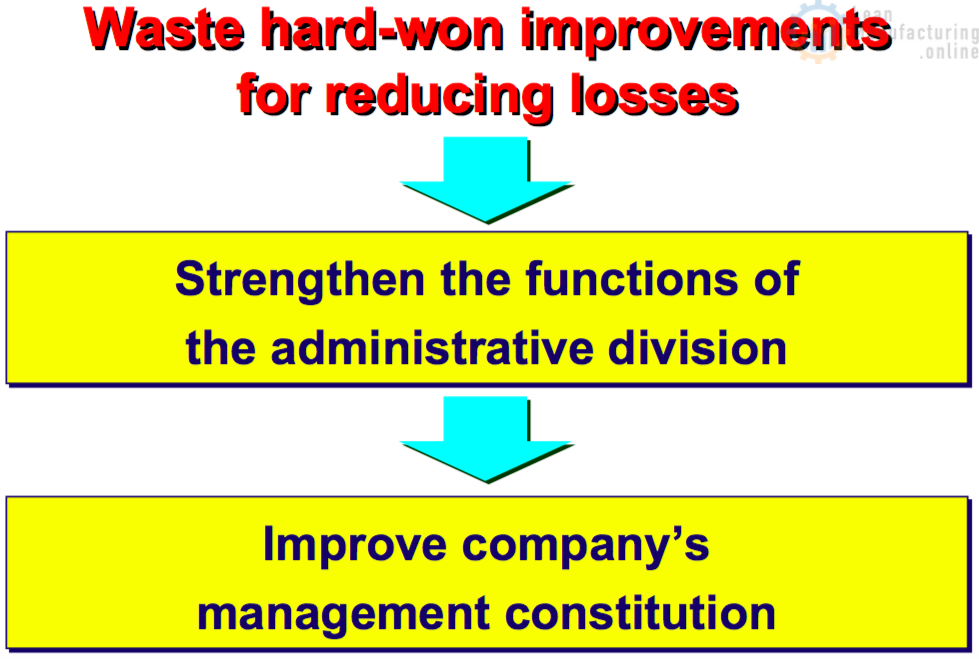
The task of the administrative division is to provide services to the manufacturing division in its processing of information. This division covers a wide swath of functions and in fact refers to sets of functions in each division. Components of the administrative division include the production management division, which covers production planning, personnel planning, inventory management, and delivery schedule management; quality assurance, which involves quality standards as well as inspection criteria and measures; the sales division, which includes the senior management Planning Office and sets sales plans and prices; the human resources division, which plans the hiring and training of personnel; and much else.
All of these administrative divisions affect the production division and other divisions. Moreover, losses occurring as a result of the actions of the administrative division are far more extensive than those generated by the production division (production workplace) itself.
Strengthening the functions of the administrative division is therefore an essential task. Without this effort, the improvement of a company or workplace’s management constitution is impossible.
Work Survey

The pie graph on the left shows how much time is taken up with each type of work, for each administrative division. This information can be used to list work functions in order of time consumption. Of course, this information alone does not tell us whether or not the division is using its time effectively.
To answer this question, work is broken down by content, as shown in the pie graph at right. A rough breakdown into basic work functions, auxiliary functions, and other functions shows that core work consists of no more than 25% of the total. While meetings, moving from one place to the other and clerical processing is all undeniably necessary, none of these actions themselves create value.
Reducing these non-value-adding tasks to the bare minimum is improving efficiency.
The Direction of Work Efficiency Improvement

Work in the core functions of the administrative division consists of work that requires judgment rather than logic, such as planning or decision-making. These tasks generally account for 20-30% of the total administrative workload.
The remaining 70-80% of the work is routine work that can be processed by straightforward logic. These functions may be called auxiliary functions. By streamlining routine tasks, the company can make more of its time and energy available for structural innovation, such as planning and creative work.
Although many managers continue to equate “improving efficiency” with activities to cut management costs, they risk missing out on the true role of the administrative division. Their efforts may not only fail to strengthen the enterprise constitution but may even weaken it.
Concept of activities

To satisfy a given function, a company must follow certain systems of operation to perform certain work actions. These systems and actions are the work mechanisms of the administrative division.
We, therefore, separate activities into three components: Function, operation, and work. These distinctions make it easier to understand the aims of activities and how they are carried out.
MAKIGAMI analysis is an approach that renders operating processes visible and views the administrative division as an “office factory.” It does this by evaluating the division in terms of QCD: How well does the administrative division provide high-quality work, at low cost, and according to the delivery schedule?
Concept of Office Factory
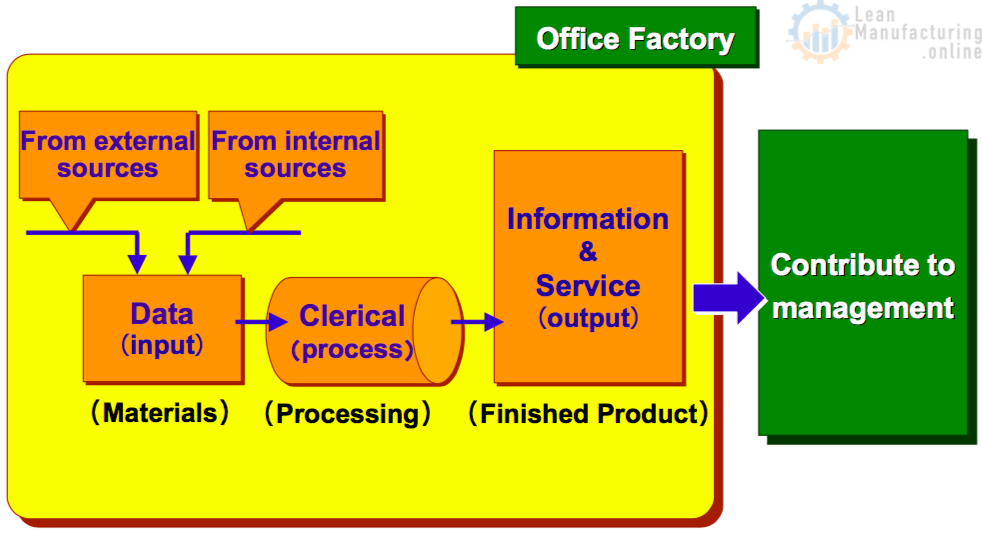
Just as a production plant processes raw materials into finished goods, the administrative division accepts the information as to its raw material or input, which it processes to output new information and services. When viewed in this way, the administrative division is indeed an “office factory.”
Modern manufacturing systems provide examples of some of the most efficient systems in the world. When compared with manufacturing systems, administrative operations clearly suffer from a wide range of problems.
Problems in Conventional Administrative Work
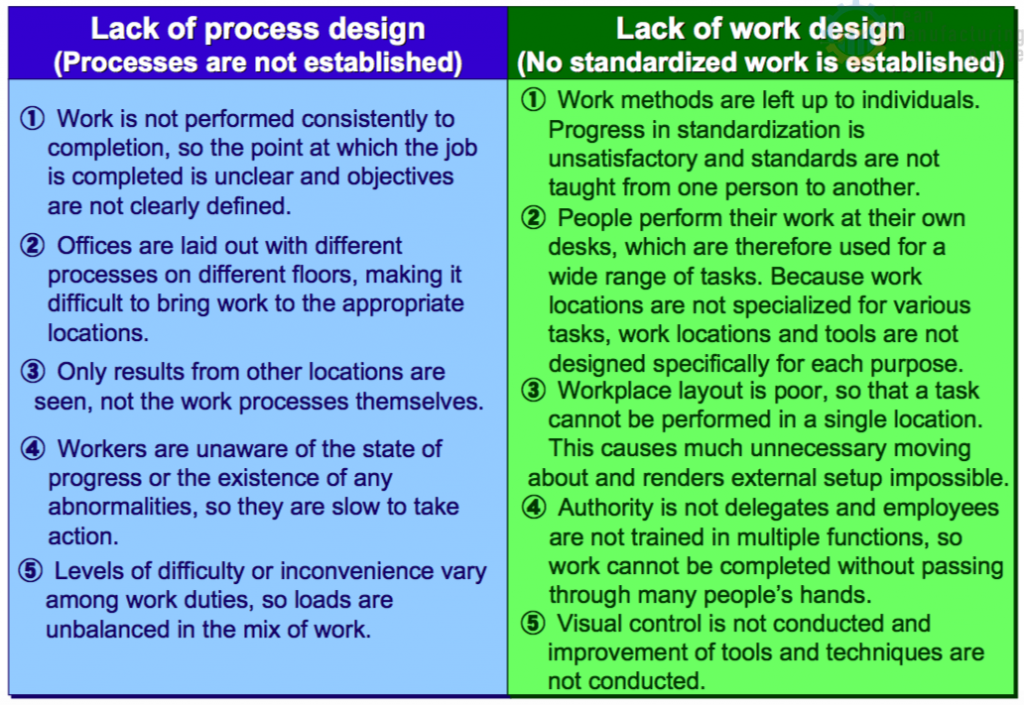
The table above summarizes the problems inherent in conventional administrative work.
In the production division, work progresses in a process from product design to process design, work design, and so on. Improvement activities are essential in all of these phases, but they also continue after the transition to the production phase, to ensure excellent work and work processes.
These processes are much less clearly defined in the administrative division. In this division, no clear decisions exist on what work is to be done as part of which process, approaches are left to the judgment of individual operators, work revolves around individuals, and other workers do not understand the processes being carried out.
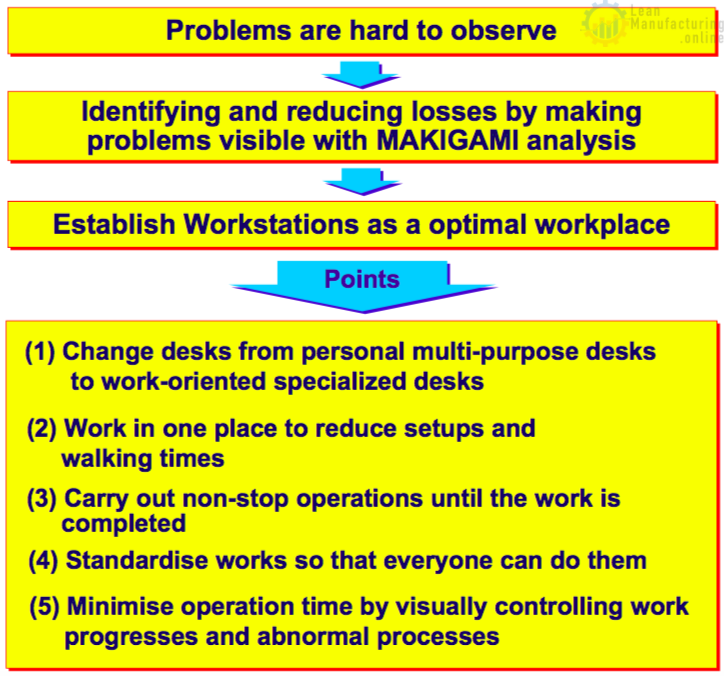
It is often said that administrative work is hard to observe. This type of work is hard to understand, and managers tend to notice problems only when results are reported, rather than taking a look at work processes for themselves. These are important reasons why progress in the improvement of administrative work is so slow.
This is why MAKIGAMI analysis is used to reproduce the true status of administrative work and visualize the work. MAKIGAMI analysis provides tools for recognizing problems and addressing them. It also provides processes in which all managers and workers can share their views on a single given operation and improve work processes.
To prevent backsliding after improvements are effected through MAKIGAMI analysis, changes must be made permanent as part of the company’s “hardware.” These hardware improvements are known as “workstations,” and the five key points in the construction of workstations are summarized in the table above.
5-Step Deployment of Office Work Efficiency
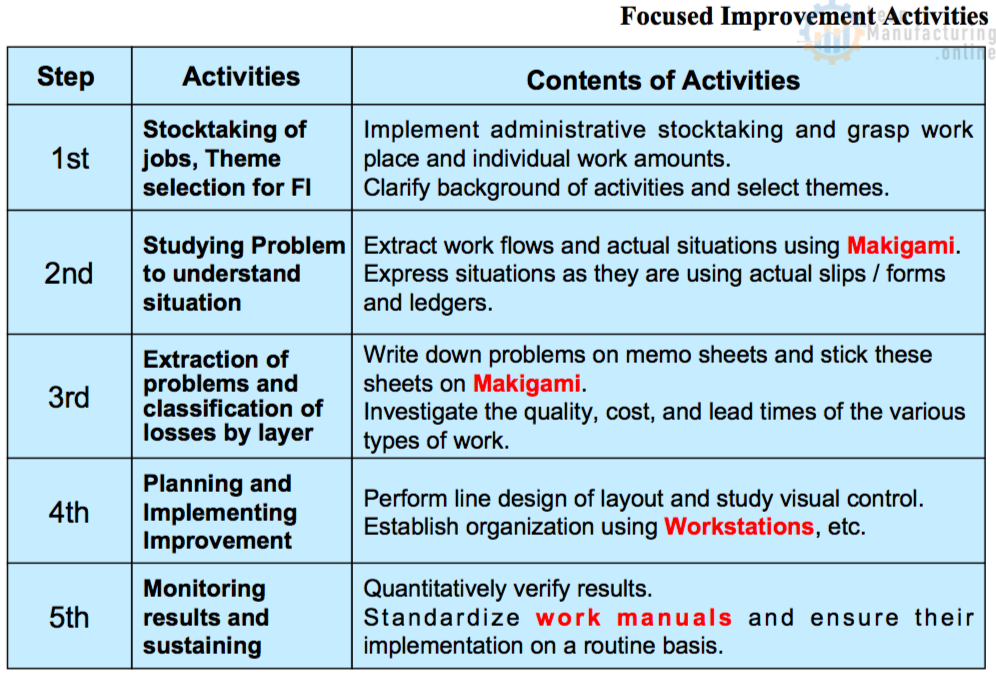
To tackle administrative efficiency, it is important to decide the details of activities for each step and proceed on a step-by-step basis.
Each company can decide for itself how to put this approach into action, but it is best explained in terms of the five-step deployment approach detailed in the table above.
In the following pages, the five-step deployment will be described from step 1 through step 5, using the example of activities carried out on actual administrative work at the General Affairs Section of a company we will call Company F. The improvement theme studied here is “50% reduction in man-hours required for payroll calculation.”
Challenge to reduce man-hour of salary calculation job to half
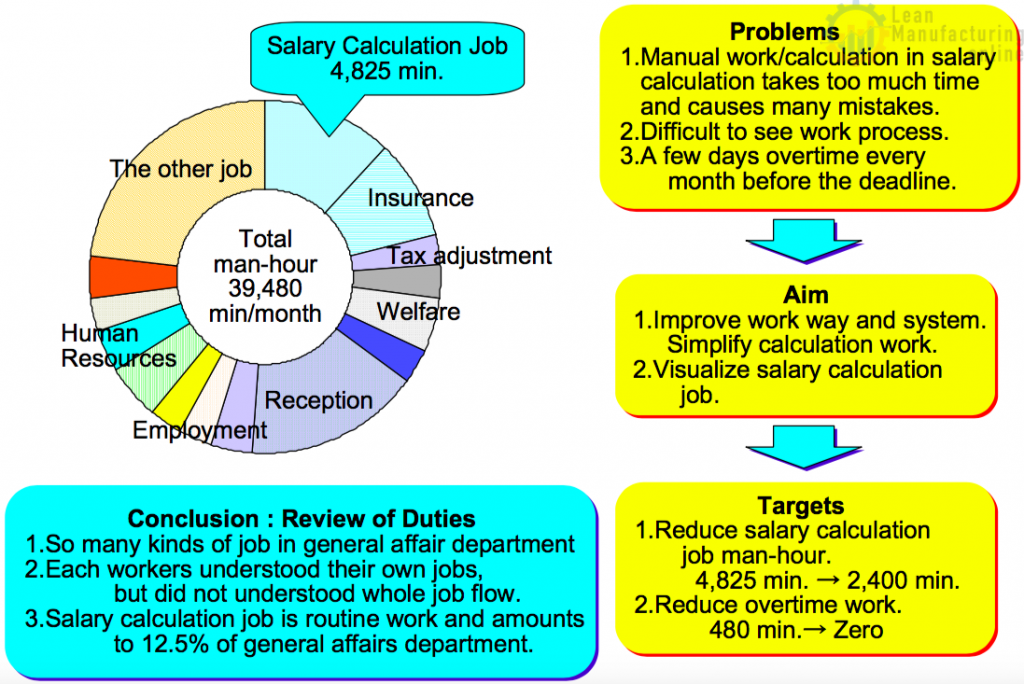
Step 1 Stocktaking of jobs, Theme selection for FI
The first step is to take stock of work. At Company F, the General Affairs Section surveys the administrative work conducted by each individual in the Section, then created a pie graph showing each work process as a share of the entire workplace’s total work time per month. This early phase is a good opportunity to canvas employees for their opinions on what areas seem to hold problems, how they can be improved, and so forth.
However, one danger is that, by carrying out comprehensive stocktaking, a great deal of labor may be expended with little benefit to show for it. The main purpose of stocktaking is to set themes for improvement; it is not useful at this point to spend too much time poring over minute details. Normally this step can be covered with about two months of studies, using daily reports and the like.
Next, meetings are held so that the results of stocktaking can be understood and collated into improvement themes. These meetings can be used to identify problems in the operations addressed by the improvement theme (in this example, payroll calculation) and determine the aims and targets of activities.
In this initial phase of activities when improvement themes are set, it is a good idea to tackle fixed, monthly operations.
Studying Problem to understand the situation

Step 2 Studying Problem to understand the situation
Understanding the actual status of the administrative division involves using MAKIGAMI to detail the flow of operations as they are. The procedure for understanding is described in the list above, but the trick is to record “the flow of operations as they are” accurately. However simple this may sound, it is in fact exceptionally difficult, since it is human nature to hide or downplay one’s weaknesses inadvertently even with the full intention, to tell the truth.
Because the purpose of MAKIGAMI analysis is to uncover losses, those who conduct the analysis must studiously avoid sugar-coating the workplace’s problems. In some cases, special care must be taken to write about work processes “as they are” by confirming the actual locations and things used in the work.
Strengthening of Administrative Division Functions through MAKIGAMI Analysis. Part 2















